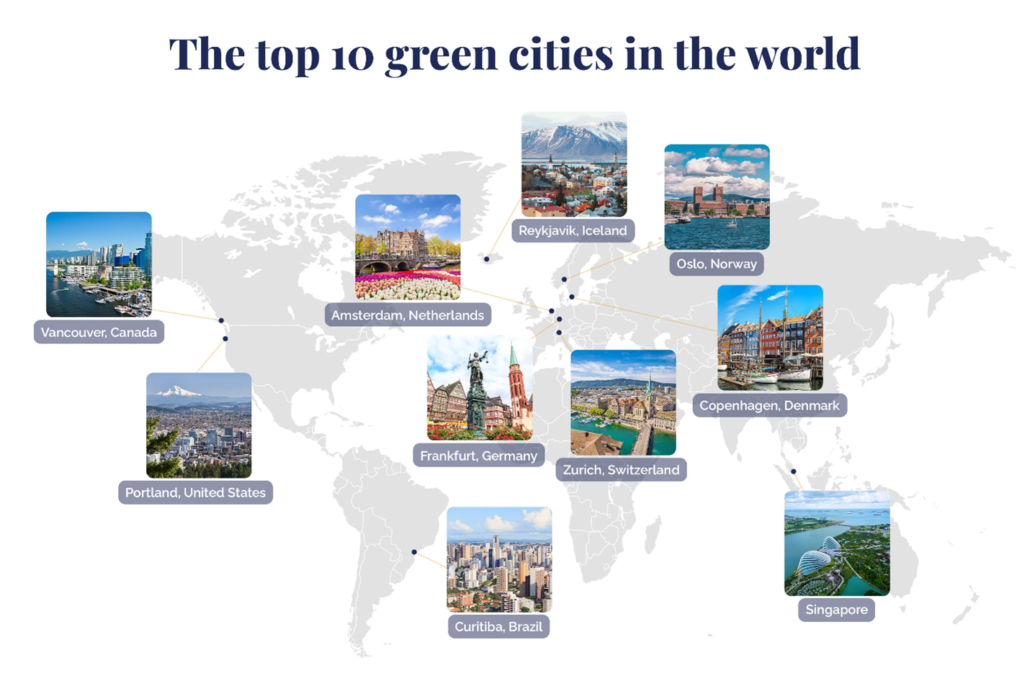Urban Sustainability and Green Cities
Urban sustainability is becoming an increasingly critical concern as the world’s population continues to urbanize at an unprecedented rate. A large proportion of the world’s population is concentrated in urban centers and is projected to increase to 70% by 2030. At the same time, cities bear the greatest responsibility for the human footprint on the environment, being responsible for more than 70% of the carbon dioxide emitted into the environment and most of the waste. Furthermore, many cities are already facing problems in air quality, solid and liquid waste management and infrastructure. These challenges must be addressed to ensure a high quality of life for their residents. This is where the concept of green cities, also known as sustainable cities, comes into play.
A green city is designed and developed with a focus on environmental responsibility, resource efficiency, and the well-being of its inhabitants. Here are several reasons why future cities must prioritize becoming green cities:
Environmental Protection:
Green cities recognize the urgent need to address climate change, reduce greenhouse gas emissions, and preserve natural resources. They embrace renewable energy sources, promote energy-efficient buildings, and encourage sustainable transportation options such as public transit, cycling, and walking. By reducing pollution, conserving water, and preserving green spaces, green cities help mitigate environmental degradation and protect ecosystems.
Resource Efficiency:
As urban populations grow, the demand for resources such as energy, water, and materials increases. Green cities emphasize resource efficiency and aim to minimize waste and consumption. They implement strategies like green building practices, smart grid systems, and efficient waste management. By optimizing resource use, green cities can reduce the strain on finite resources, promote circular economy models, and contribute to long-term sustainability.
Health and Well-being:
The design of green cities takes into account the health and well-being of residents. Access to clean air, green spaces, and safe walking and cycling infrastructure promotes physical activity, reduces stress levels, and improves mental health. Green buildings with enhanced indoor air quality and natural lighting create healthier living and working environments. By prioritizing human well-being, green cities can enhance the quality of life for their inhabitants.
Economic Opportunities:
Green cities can generate economic opportunities and drive innovation. Investments in renewable energy, energy-efficient technologies, and sustainable infrastructure can create jobs, attract businesses, and stimulate economic growth. Additionally, green cities often foster entrepreneurship and support the development of green industries, such as clean technology and sustainable agriculture. By embracing sustainability, cities can enhance their competitiveness and create a more resilient economy.
Community Engagement and Social Equity:
Green cities prioritize community engagement and inclusivity. They involve residents in decision-making processes, encourage sustainable behaviors through education and awareness campaigns, and promote social equity. Accessible public transportation, affordable housing, and equitable distribution of green spaces ensure that all residents benefit from sustainable initiatives. By fostering social cohesion and addressing social disparities, green cities build stronger, more resilient communities.
Climate Change Adaptation:
Green cities recognize the need to adapt to the impacts of climate change. They incorporate resilience measures such as flood management systems, green infrastructure, and urban heat island mitigation strategies. By implementing adaptive strategies, green cities can reduce vulnerability to climate-related risks and enhance their ability to withstand and recover from extreme weather events.
In summary, the imperative of urban sustainability necessitates the transformation of future cities into green cities. By prioritizing environmental protection, resource efficiency, health and well-being, economic opportunities, community engagement, and climate change adaptation, green cities can create more livable, resilient, and prosperous urban environments. It is crucial for policymakers, urban planners, businesses, and residents to work together to build sustainable cities that meet the needs of the present without compromising the ability of future generations to meet their own needs.
Here, we have compiled a list of the top 10 green cities in the world, updated for 2023.

Source: https://www.green.earth/

